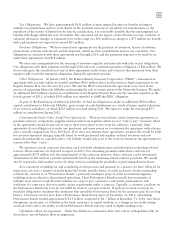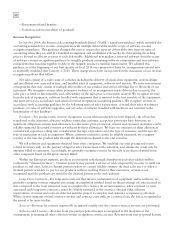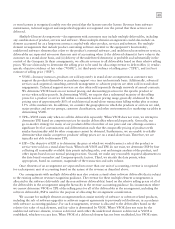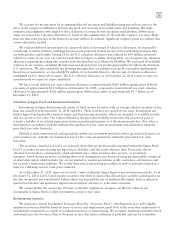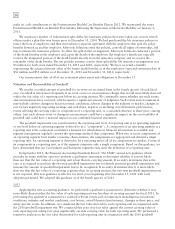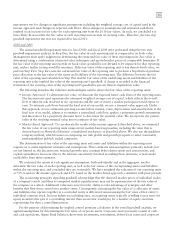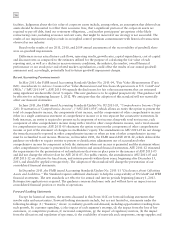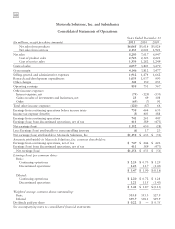Motorola 2011 Annual Report Download - page 57
Download and view the complete annual report
Please find page 57 of the 2011 Motorola annual report below. You can navigate through the pages in the report by either clicking on the pages listed below, or by using the keyword search tool below to find specific information within the annual report.
51
We account for income taxes by recognizing deferred tax assets and liabilities using enacted tax rates for the
effect of the temporary differences between the book and tax basis of recorded assets and liabilities. We make
estimates and judgments with regard to the calculation of certain income tax assets and liabilities. Deferred tax
assets are reduced by valuation allowances if, based on the consideration of all available evidence, it is more-likely-
than-not that some portion of the deferred tax asset will not be realized. Significant weight is given to evidence that
can be objectively verified.
We evaluate deferred income taxes on a quarterly basis to determine if valuation allowances are required by
considering available evidence, including historical and projected taxable income and tax planning strategies that
are both prudent and feasible. During 2010, the U.S. valuation allowance was reduced by $39 million, primarily
related to certain of our state tax carryforwards that we expect to utilize. During 2011, we reassessed our valuation
allowance requirements taking into consideration the distribution of Motorola Mobility. We evaluated all available
evidence in our analysis, including the historical and projected pre-tax profits generated by the Motorola Solutions
U.S. operations. We also considered tax planning strategies that are prudent and can be reasonably implemented.
Based on our assessment, we recorded $274 million of tax benefits related to the reversal of valuation allowance
established on U.S. deferred tax assets. The U.S. valuation allowance as of December 31, 2011 relates to state tax
carryforwards we expect to expire unutilized.
We have a total deferred tax asset valuation allowance of approximately $366 million against gross deferred
tax assets of approximately $5.1 billion as of December 31, 2011, compared to total deferred tax asset valuation
allowance of approximately $502 million against gross deferred tax assets of approximately $5.7 billion as of
December 31, 2010.
Valuation of Sigma Fund and Investment Portfolios
Investments in Sigma Fund primarily consist of fixed income securities with an average effective maturity of less
than one month at both December 31, 2011 and 2010. These securities are carried at fair value. Investments not
held in Sigma Fund generally consist of equity and fixed income securities, which are classified as available-for-sale
and are carried at fair value. Fair value is defined as the price that would be received to sell an asset or paid to
transfer a liability in an orderly transaction between market participants as of the measurement date. Fair value is
determined in accordance with the authoritative guidance for fair value measurements and disclosures using the
prescribed fair value hierarchy.
Publicly traded common stock and equivalents within our investment portfolios where quoted market prices in
active markets are available are classified as Level 1 fair value measurements within the prescribed fair value
hierarchy.
The securities classified as Level 2 are primarily those that are professionally managed within the Sigma Fund.
Level 2 securities are priced using pricing services, bid/offer, and last trade reference data. Prices may also be
obtained from brokers, counterparties, fund administrators, online securities data services, or investment
managers. Fixed income securities, including short-term instruments, may be priced using pricing models comprised
of observable inputs which include, but are not limited to, market quotations, yields, maturities, call features, and
the security’s terms and conditions. We review these prices and pricing procedures as well as amounts realized as a
basis for validating our fair value price estimates.
As of December 31, 2011, there are no Level 3 assets within the Sigma Fund or our investment portfolio. As of
December 31, 2010, Level 3 fixed income securities were debt securities that did not have actively traded quotes on
the date we present our consolidated balance sheet and required the use of unobservable inputs, such as indicative
quotes from dealers and qualitative input from investment advisors, to value these securities.
We cannot predict the occurrence of future events that might have an impact on the fair values of our
investments in Sigma Fund or other investments carried at fair value.
Restructuring Activities
We maintain a formal Involuntary Severance Plan (the “Severance Plan”), which permits us to offer eligible
employees severance benefits based on years of service and employment grade level in the event that employment is
involuntarily terminated as a result of a reduction-in-force or restructuring. We recognize termination benefits based
on formulas per the Severance Plan at the point in time that future settlement is probable and can be reasonably






